Energy Storage Management of a Solar Photovoltaic–Biomass Hybrid Power System
Abstract
1. Introduction
Scope of the Proposed Research (Aims and Objectives)
2. Proposed Control Algorithm Strategy
Power Stability Algorithm for the Integrated Energy System
3. Methods and Materials Application
3.1. Area of Study: Tha Sala (Muang Lopburi)
3.2. Load Profile for Residential, Community, and Commercial Areas of Muang Lopburi
3.3. Biomass Potential Resources of Lopburi Province
3.4. Hybrid Power System Microgrid Network Modeling
3.4.1. Solar Photovoltaic Power Plant
3.4.2. Biomass Gasifier–Biogas Power Plant
3.4.3. Storage Unit (Li, NaS, Fe batteries) Bank
Charging State (SChr)
Supplying Potential of the Battery
Batteries Energy Storage Limitation
3.4.4. Integrated Power Conversion–Charging Controller
3.4.5. Electrical Power Generation ((EGEN (t))
3.4.6. Power Flywheel Storage System (PFSS)
3.4.7. Stability Equation of Power Generation and Load Demand
4. Results and Discussion
4.1. Fuel Curve and Emissions from Biomass Resources
4.2. Integrated Island (Off Grid) Energy System Architecture
4.2.1. Electric Power Consumption
4.2.2. Thermal Consumption
4.2.3. Sodium–Sulfur (NaS), Iron Flow (Fe-ESS), Lithium Nickel Manganese Cobalt Oxide (Li-NMC), and Flywheel Energy Storage Units
4.2.4. Hybrid Power Grid System Network
Breakeven Distance and Grid Extension
4.2.5. Bidirectional Converter (GTP519S)
4.2.6. Microgrid Hybrid Renewable Energy System Impact on Greenhouse Gas Emissions
5. Conclusions
Author Contributions
Funding
Data Availability Statement
Acknowledgments
Conflicts of Interest
References
- Renewable Energy Agency. Thailand Renewable Energy Outlook Based on Renewables Readiness Assessment and Remap Analysis; Renewable Energy Agency: Masdar City, United Arab Emirates, 2017. [Google Scholar]
- Che, L.; Zhang, X.; Shahidehpour, M.; Alabdulwahab, A.; Abusorrah, A. Optimal interconnection planning of community microgrids with renewable energy sources. IEEE Trans. Smart Grid 2017, 8, 1054–1063. [Google Scholar] [CrossRef]
- Lv, T.; Ai, Q. Interactive energy management of networked microgrids-based active distribution system considering large-scale integration of renewable energy resources. Appl. Energy 2016, 163, 408–422. [Google Scholar] [CrossRef]
- Jung, J.; Villaran, M. Optimal planning and design of hybrid renewable energy systems for microgrids. Renew. Sustain. Energy Rev. 2017, 75, 180–191. [Google Scholar] [CrossRef]
- Khalid, M.; Ahmadi, A.; Savkin, A.V.; Agelidis, V.G. Minimizing the energy cost for microgrids integrated with renewable energy resources and conventional generation using controlled battery energy storage. Renew. Energy 2016, 97, 646–655. [Google Scholar] [CrossRef]
- Qamar, A.; Iqbal, J.; Saher, S.; Shah, A.A.; Basit, A. Design of optimized energy system based on active energy-saving technologies in very low-energy smart buildings. Trans. Emerg. Telecommun. Technol. 2022, 33, e3691. [Google Scholar] [CrossRef]
- Patel, A.M.; Singal, S.K. Optimal component selection of integrated renewable energy system for power generation in stand-alone applications. Energy 2019, 175, 481–504. [Google Scholar] [CrossRef]
- Ramesh, M.; Saini, R.P. Dispatch strategies based performance analysis of a hybrid renewable energy system for a remote rural area in India. J. Clean. Prod. 2020, 259, 120697. [Google Scholar] [CrossRef]
- Upadhyay, S.; Sharma, M. Selection of a suitable energy management strategy for a hybrid energy system in a remote rural area of India. Energy 2016, 94, 352–366. [Google Scholar] [CrossRef]
- Rajanna, S.; Saini, R. Modeling of integrated renewable energy system for electrification of a remote area in India. Renew. Energy 2016, 90, 175–187. [Google Scholar] [CrossRef]
- Bhatt, A.; Sharma, M.; Saini, R. Feasibility and sensitivity analysis of an off-grid micro hydro–photovoltaic–biomass and biogas–diesel–battery hybrid energy system for a remote area in Uttarakhand state, India. Renew. Sustain. Energy Rev. 2016, 61, 53–69. [Google Scholar] [CrossRef]
- Shezan, S.; Julai, S.; Kibria, M.; Ullah, K.; Saidur, R.; Chong, W.; Akikur, R. Performance analysis of an off-grid wind-PV (photovoltaic)-diesel-battery hybrid energy system feasible for remote areas. J. Clean. Prod. 2016, 125, 121–132. [Google Scholar] [CrossRef]
- Durlinger, B.; Reinders, A.; Toxopeus, M. A comparative life cycle analysis of low power PV lighting products for rural areas in South East Asia. Renew. Energy 2012, 41, 96–104. [Google Scholar] [CrossRef]
- Lao, C.; Chungpaibulpatana, S. Techno-economic analysis of hybrid system for rural electrification in Cambodia. Energy Procedia 2017, 138, 524–529. [Google Scholar] [CrossRef]
- Rodríguez-Gallegos, C.D.; Gandhi, O.; Bieri, M.; Reindl, T.; Panda, S. A diesel replacement strategy for off-grid systems based on progressive introduction of PV and batteries: An Indonesian case study. Appl. Energy 2018, 229, 1218–1232. [Google Scholar] [CrossRef]
- Kim, H.; Jung, T.Y. Independent solar photovoltaic with Energy Storage Systems (ESS) for rural electrification in Myanmar. Renew. Sustain. Energy Rev. 2018, 82, 1187–1194. [Google Scholar] [CrossRef]
- Kohsri, S.; Meechai, A.; Prapainainar, C.; Narataruksa, P.; Hunpinyo, P.; Sin, G. Design and preliminary operation of a hybrid syngas/solar PV/battery power system for off-grid applications: A case study in Thailand. Chem. Eng. Res. Des. 2018, 131, 346–361. [Google Scholar] [CrossRef]
- Lozano, L.; Querikiol, E.M.; Abundo, M.L.S.; Bellotindos, L.M. Techno-economic analysis of a cost-effective power generation system for off-grid island communities: A case study of Gilutongan Island, Cordova, Cebu, Philippines. Renew. Energy 2019, 140, 905–911. [Google Scholar] [CrossRef]
- Moretti, L.; Astolfi, M.; Vergara, C.; Macchi, E.; Pérez-Arriaga, J.I.; Manzolini, G. A design and dispatch optimization algorithm based on mixed integer linear programming for rural electrification. Appl. Energy 2018, 233–234, 1104–1121. [Google Scholar] [CrossRef]
- Ciez, R.E.; Whitacre, J. Comparative techno-economic analysis of hybrid micro-grid systems utilizing different battery types. Energy Convers. Manag. 2016, 112, 435–444. [Google Scholar] [CrossRef]
- Merei, G.; Berger, C.; Sauer, D.U. Optimization of an off-grid hybrid PV–Wind–Diesel system with different battery technologies using genetic algorithm. Sol. Energy 2013, 97, 460–473. [Google Scholar] [CrossRef]
- Moretti, L.; Polimeni, S.; Meraldi, L.; Raboni, P.; Leva, S.; Manzolini, G. Assessing the impact of a two-layer predictive dispatch algorithm on design and operation of offgrid hybrid microgrids. Renew. Energy 2019, 143, 1439–1453. [Google Scholar] [CrossRef]
- Kaabeche, A.; Bakelli, Y. Renewable hybrid system size optimization considering various electrochemical energy storage technologies. Energy Convers. Manag. 2019, 193, 162–175. [Google Scholar] [CrossRef]
- Paul, S.; Schirmer, T.; Kairies, K.; Axelsen, H.; Uwe, D. Comparison of o ff -grid power supply systems using lead-acid and lithium-ion batteries. Sol. Energy 2018, 162, 140–152. [Google Scholar] [CrossRef]
- Luo, F.; Meng, K.; Dong, Z.Y.; Zheng, Y.; Chen, Y.; Wong, K.P. Coordinated operational planning for wind farm with battery energy storage system. IEEE Trans. Sustain. Energy 2015, 6, 253–262. [Google Scholar] [CrossRef]
- Dreidy, M.; Mokhlis, H.; Mekhilef, S. Inertia response and frequency control techniques for renewable energy sources: A review. Renew. Sustain. Energy Rev. 2017, 69, 144–155. [Google Scholar] [CrossRef]
- Arcos-Aviles, D.; Pascual, J.; Marroyo, L.; Sanchis, P.; Guinjoan, F. Fuzzy logic-based energy management system design for residential grid-connected microgrids. IEEE Trans. Smart Grid 2018, 9, 530–543. [Google Scholar] [CrossRef]
- Koller, M.; Borsche, T.; Ulbig, A.; Andersson, G. Review of grid applications with the Zurich 1 MWbattery energy storage system. Electr Power Syst. Re.s 2015, 120, 128–135. [Google Scholar] [CrossRef]
- Huang, W.; Qahouq, J.A.A. Energy sharing control scheme for state-of-charge balancing of distributed battery energy storage system. IEEE Trans. Ind. Electron. 2015, 62, 2764–2776. [Google Scholar] [CrossRef]
- Oudalov, A.; Cherkaoui, R.; Beguin, A. Sizing and optimal operation of battery energy storage system for peak shaving application. In Proceedings of the 2007 IEEE Lausanne POWERTECH, Lausanne, Switzerland, 1–5 July 2007; pp. 621–625. [Google Scholar] [CrossRef]
- Nazaripouya, H.; Wang, Y.; Chu, P.; Pota, H.R.; Gadh, R. Optimal sizing and placement of battery energy storage in distribution system based on solar size for voltage regulation. In Proceedings of the IEEE Power and Energy Society General Meeting, Denver, CO, USA, 26–30 July 2015; Volume 2015. [Google Scholar] [CrossRef]
- Wang, X.; Yue, M.; Muljadi, E. PV generation enhancement with a virtual inertia emulator to provide inertial response to the grid. In Proceedings of the 2014 IEEE Energy Conversion Congress and Exposition, ECCE 2014, Pittsburgh, PA, USA, 14–18 September 2014; pp. 17–23. [Google Scholar] [CrossRef]
- Hemmati, R. Technical and economic analysis of home energy management system incorporating small-scale wind turbine and battery energy storage system. J. Clean. Prod. 2017, 159, 106–118. [Google Scholar] [CrossRef]
- Zakeri, B.; Syri, S. Electrical energy storage systems: A comparative life cycle cost analysis. Renew. Sustain. Energy Rev. 2015, 42, 569–596. [Google Scholar] [CrossRef]
- Staffell, I.; Scamman, D.; Velazquez Abad, A.; Balcombe, P.; Dodds, P.E.; Ekins, P.; Shah, N.; Ward, K.R. The role of hydrogen and fuel cells in the global energy system. Energy Environ. Sci. 2019, 12, 463–491. [Google Scholar] [CrossRef]
- Chen, Z.; Mi, C.; Fu, Y.; Xu, J.; Gong, X. Online battery state of health estimation based on Genetic Algorithm for electric and hybrid vehicle applications. J. Power Sources 2013, 240, 184–192. [Google Scholar] [CrossRef]
- Kim, T.; Song, W.; Son, D.Y.; Ono, L.K.; Qi, Y. Lithium-ion batteries: Outlook on present, future, and hybridized technologies. J. Mater. Chem. 2019, 7, 2942–2964. [Google Scholar] [CrossRef]
- Zhang, W.; Liu, Y.; Guo, Z. Approaching high-performance potassium-ion batteries via advanced design strategies and engineering. Sci. Adv. 2019, 5, eaav7412. [Google Scholar] [CrossRef]
- Famprikis, T.; Canepa, P.; Dawson, J.A.; Islam, M.S.; Masquelier, C. Fundamentals of inorganic solid-state electrolytes for batteries. Nat. Mater. 2019, 18, 1278–1291. [Google Scholar] [CrossRef]
- Tan, K.M.; Babu, T.S.; Ramachandaramurthy, V.K.; Kasinathan, P.; Solanki, S.G.; Raveendran, S.K. Empowering smart grid: A comprehensive review of energy storage technology and application with renewable energy integration. J. Energy Storage 2021, 39, 102591. [Google Scholar] [CrossRef]
- Wei, Q.; Shi, G.; Song, R.; Liu, Y. Adaptive Dynamic Programming-Based Optimal Control Scheme for Energy Storage Systems with Solar Renewable Energy. IEEE Trans. Ind. Electron. 2017, 64, 5468–5478. [Google Scholar] [CrossRef]
- Xu, Y.; Zhang, W.; Hug, G.; Kar, S.; Li, Z. Cooperative Control of Distributed Energy Storage Systems in a Microgrid. IEEE Trans. Smart Grid 2014, 6, 238–248. [Google Scholar] [CrossRef]
- Morstyn, T.; Hredzak, B.; Agelidis, V.G. Control strategies for microgrids with distributed energy storage systems: An overview. IEEE Trans. Smart Grid 2018, 9, 3652–3666. [Google Scholar] [CrossRef]
- Lawder, M.T.; Suthar, B.; Northrop, P.W.C.; Sumitava, D.; Hoff, C.M.; Leitermann, O.; Crow, M.L.; Santhanagopalan, S.; Subramanian, V.R. Battery Energy Storage System (BESS) and Battery Management System (BMS) for Grid-Scale Applications. Proc. IEEE 2014, 102, 1014–1030. [Google Scholar] [CrossRef]
- Bruce, P.G.; Freunberger, S.A.; Hardwick, L.J.; Tarascon, J.M. LigO2 and LigS batteries with high energy storage. Nat. Mater. 2012, 11, 19–29. [Google Scholar] [CrossRef] [PubMed]
- Muzaffar, A.; Ahamed, M.B.; Deshmukh, K.; Thirumalai, J. A review on recent advances in hybrid supercapacitors: Design, fabrication and applications. Renew. Sustain. Energy Rev. 2019, 101, 123–145. [Google Scholar] [CrossRef]
- Poonam, K.; Sharma, A.A.; Tripathi, S.K. Review of supercapacitors: Materials and devices. J. Energy Storage 2019, 21, 801–825. [Google Scholar] [CrossRef]
- Dunn, B.; Kamath, H.; Tarascon, J.M. Electrical energy storage for the grid: A battery of choices. Science (80-) 2011, 334, 928–935. [Google Scholar] [CrossRef]
- Kumar, P.P.; Saini, R.P. Optimization of an off-grid integrated hybrid renewable energy system with different battery technologies for rural electrification in India. J. Energy Storage 2020, 32, 101912. [Google Scholar] [CrossRef]
- Global Solar Atlas. Global Solar Atlas 2.0, a Free, Web-Based Application is Developed and Operated by the Company Solargis sro on behalf of the World Bank Group, Utilizing Solargis Data, With Funding Provided by the Energy Sector Management Assistance Program (ESMAP). 2022. Available online: https://globalsolaratlas.info/ (accessed on 25 November 2022).
- Ali, A.Y.; Basit, A.; Ahmad, T.; Qamar, A.; Iqbal, J. Optimizing coordinated control of distributed energy storage system in microgrid to improve battery life. Comput. Electr. Eng. 2020, 86, 106741. [Google Scholar] [CrossRef]
- Mokhtara, C.; Negrou, B.; Settou, N.; Settou, B.; Samy, M.M. Design optimization of off-grid Hybrid Renewable Energy Systems considering the effects of building energy performance and climate change: Case study of Algeria. Energy 2020, 219, 119605. [Google Scholar] [CrossRef]
- Olivier, J.C.; Bernard, N.; Trieste, S.; Bourguet, S.; Aranguren, L.M.; Ireena, L. Techno-economic Optimization of Flywheel Storage System in transportation. In Proceedings of the Symposium de Génie Électrique 2014, Cachan, France, July 2014; pp. 8–10. [Google Scholar]

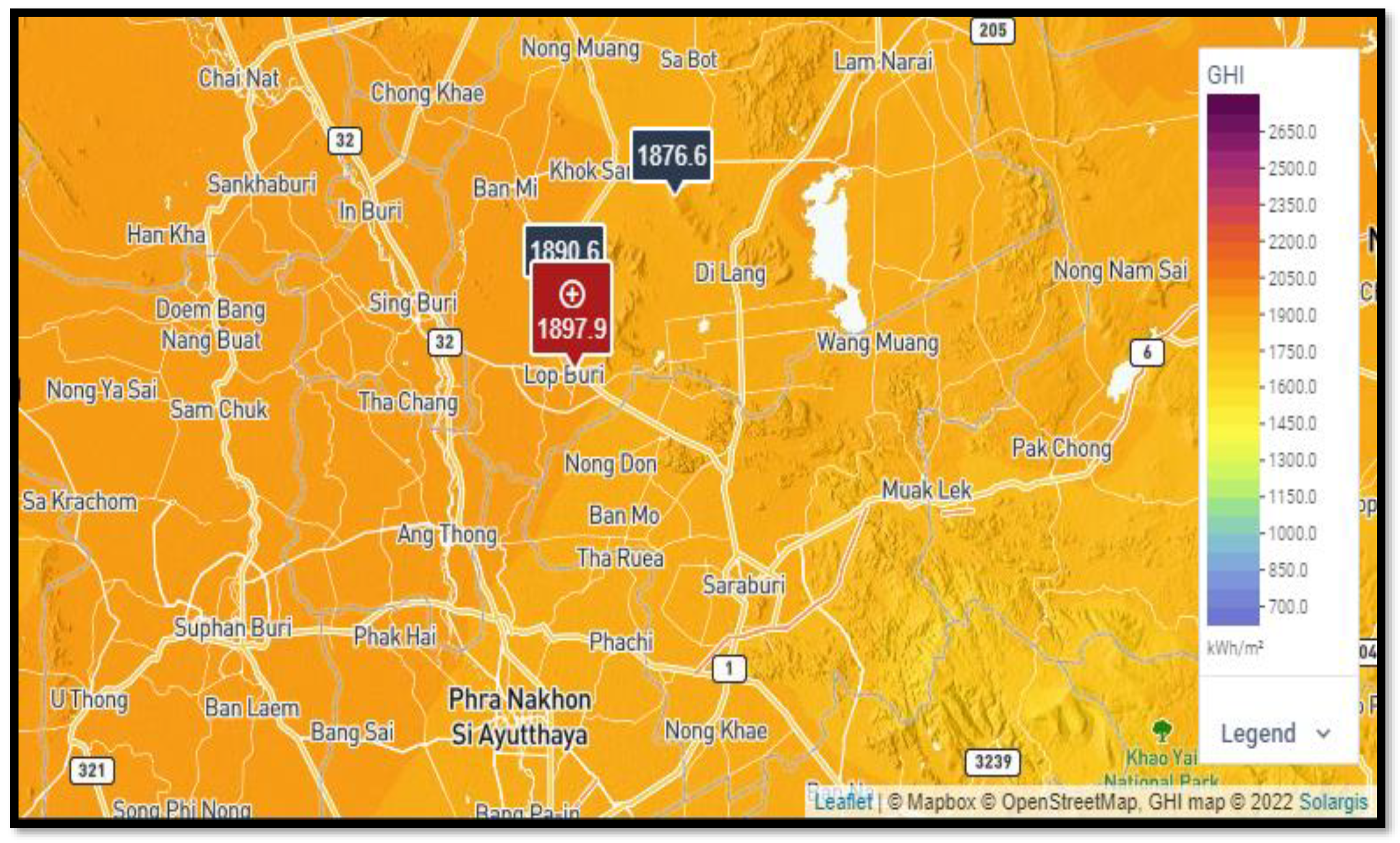
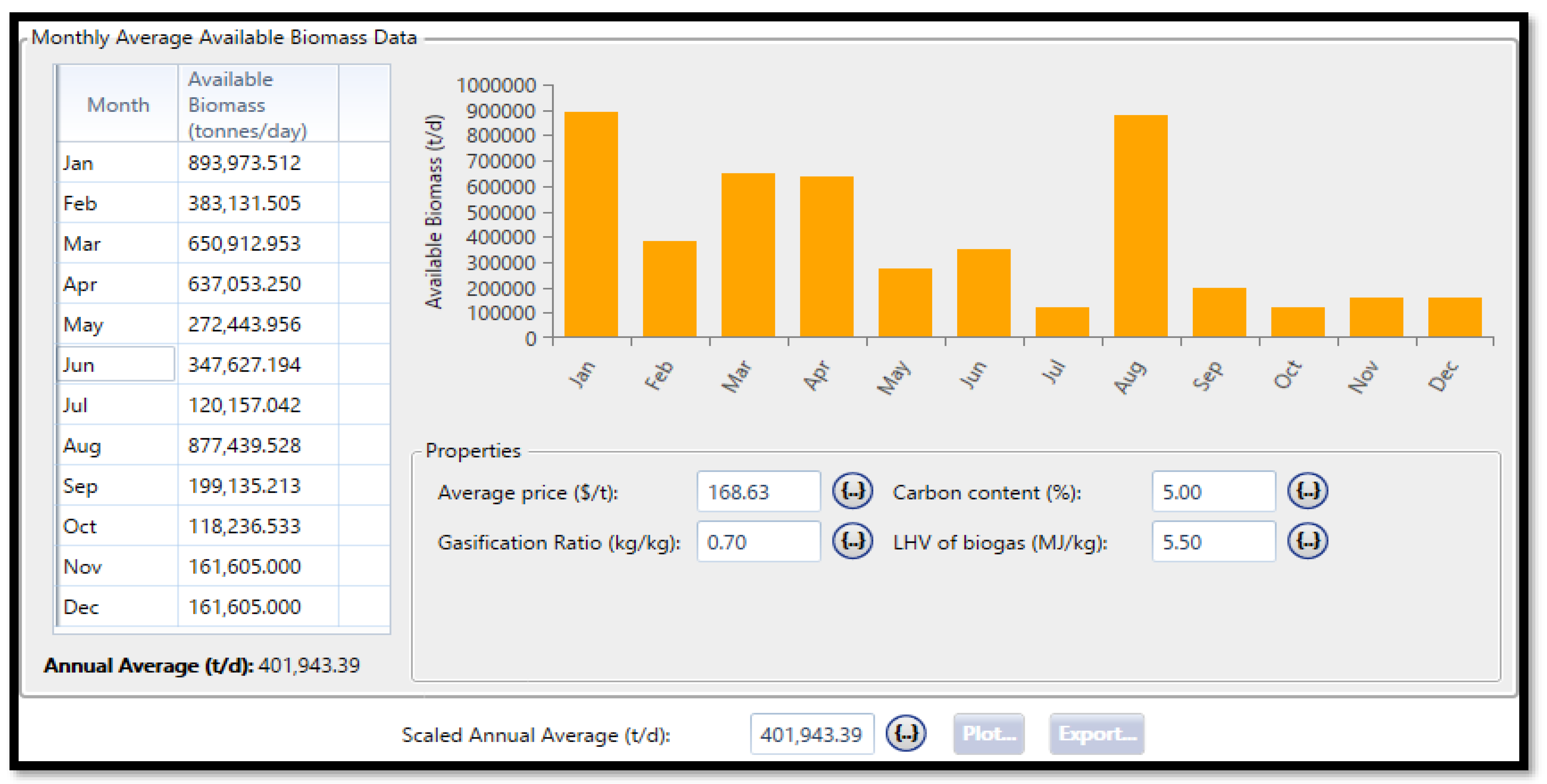
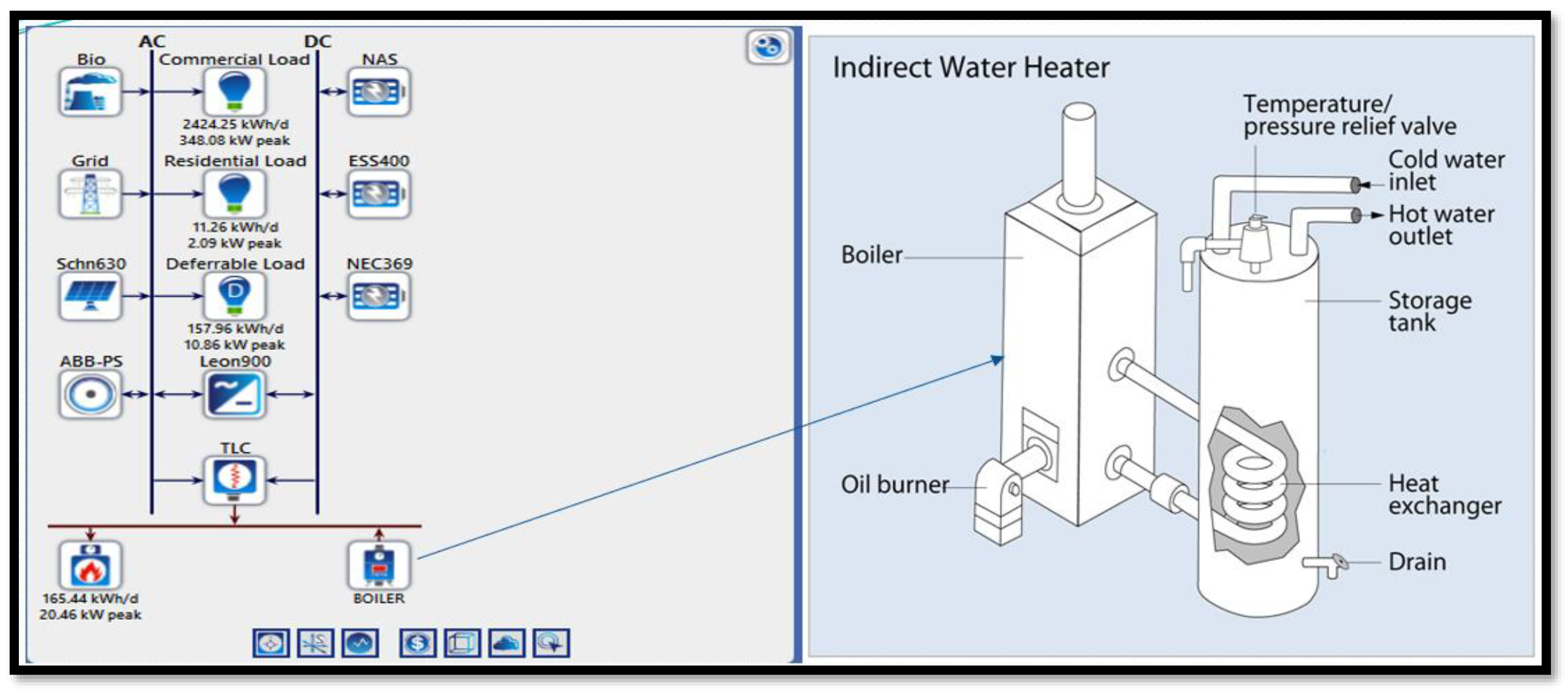
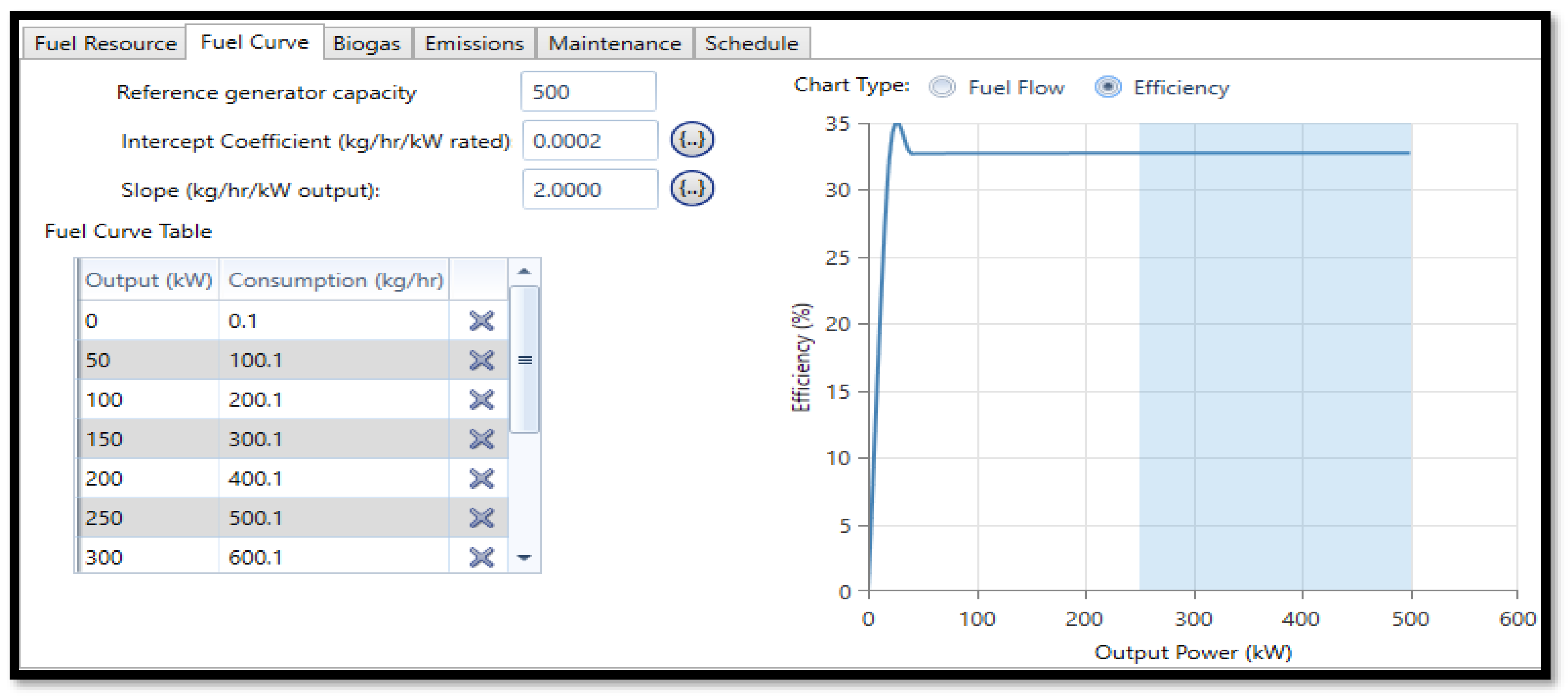

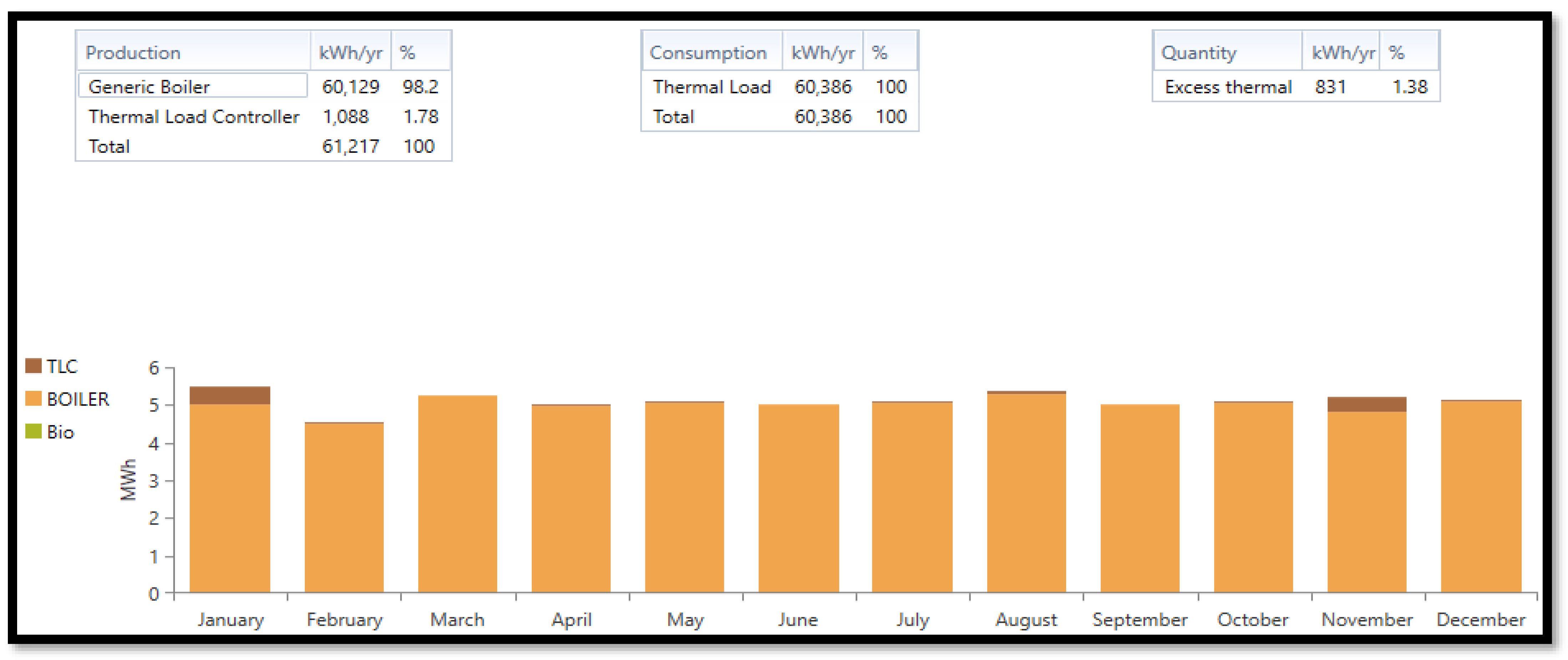
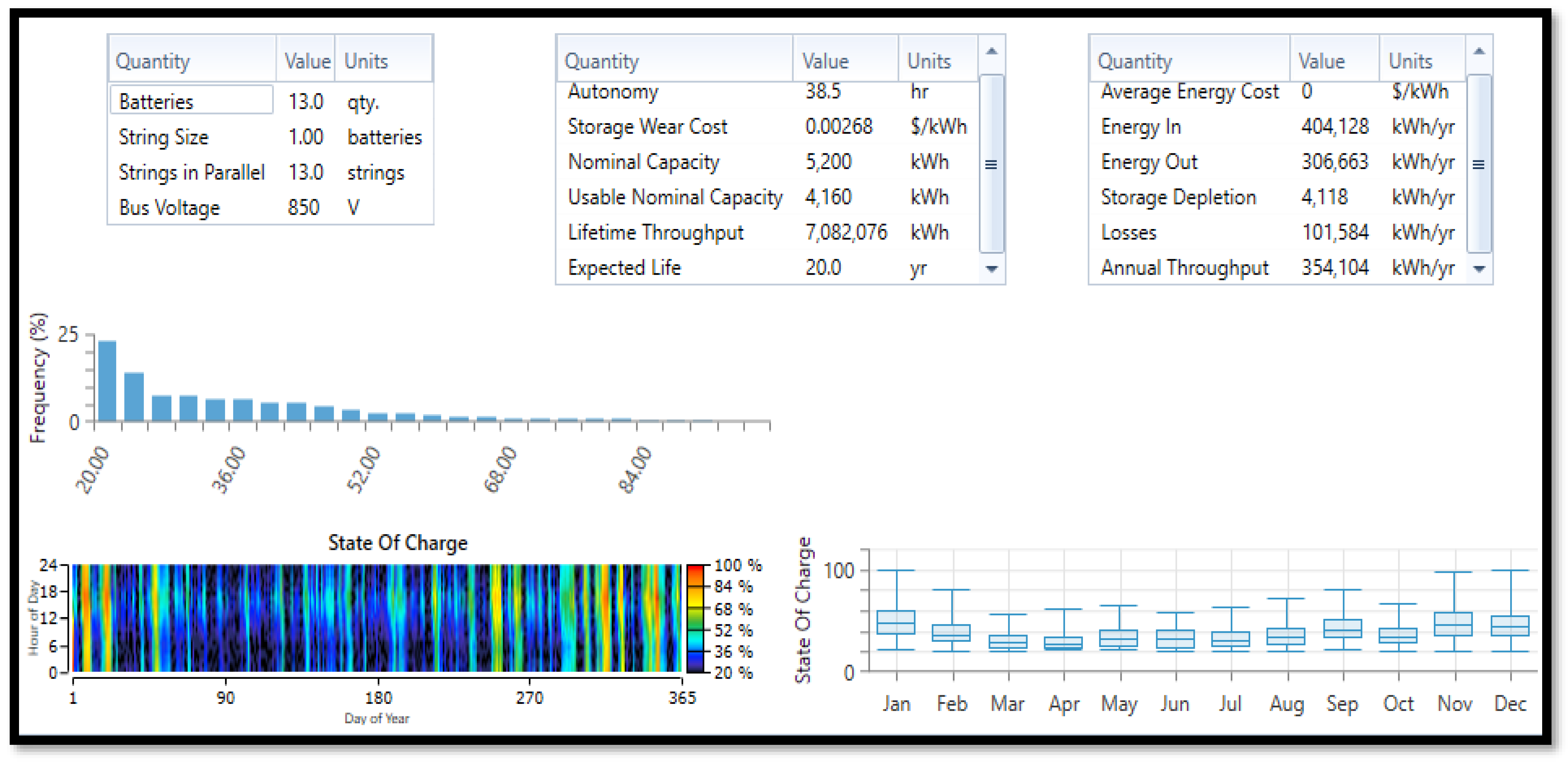
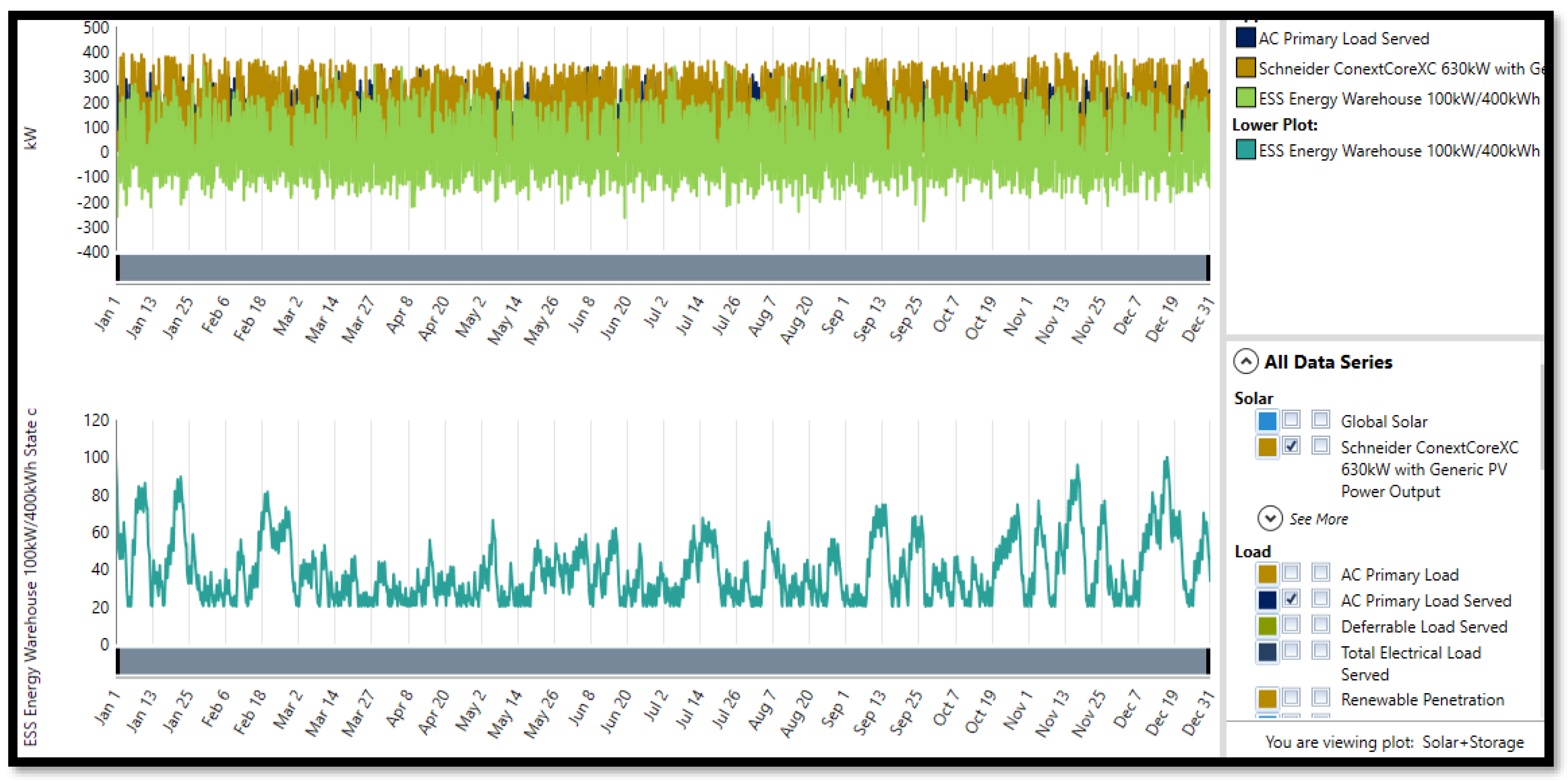
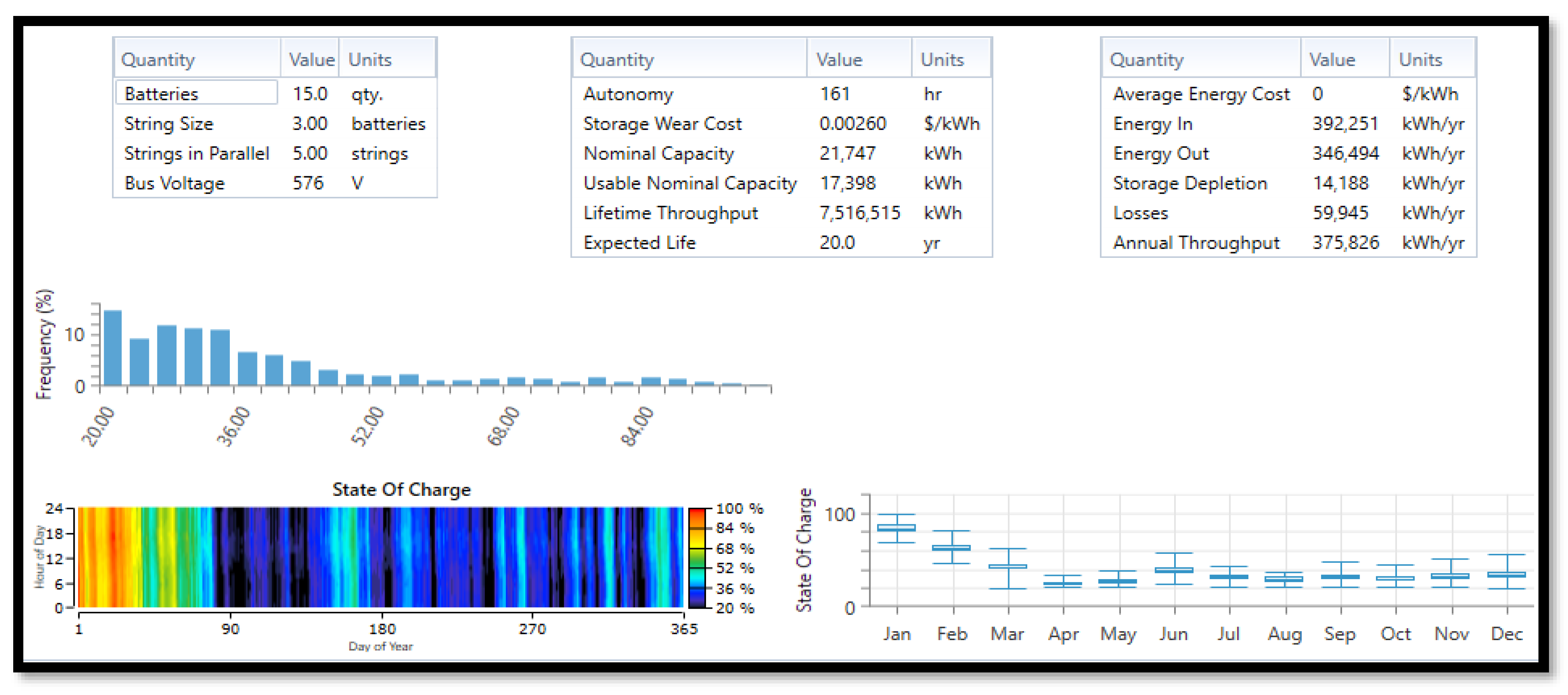

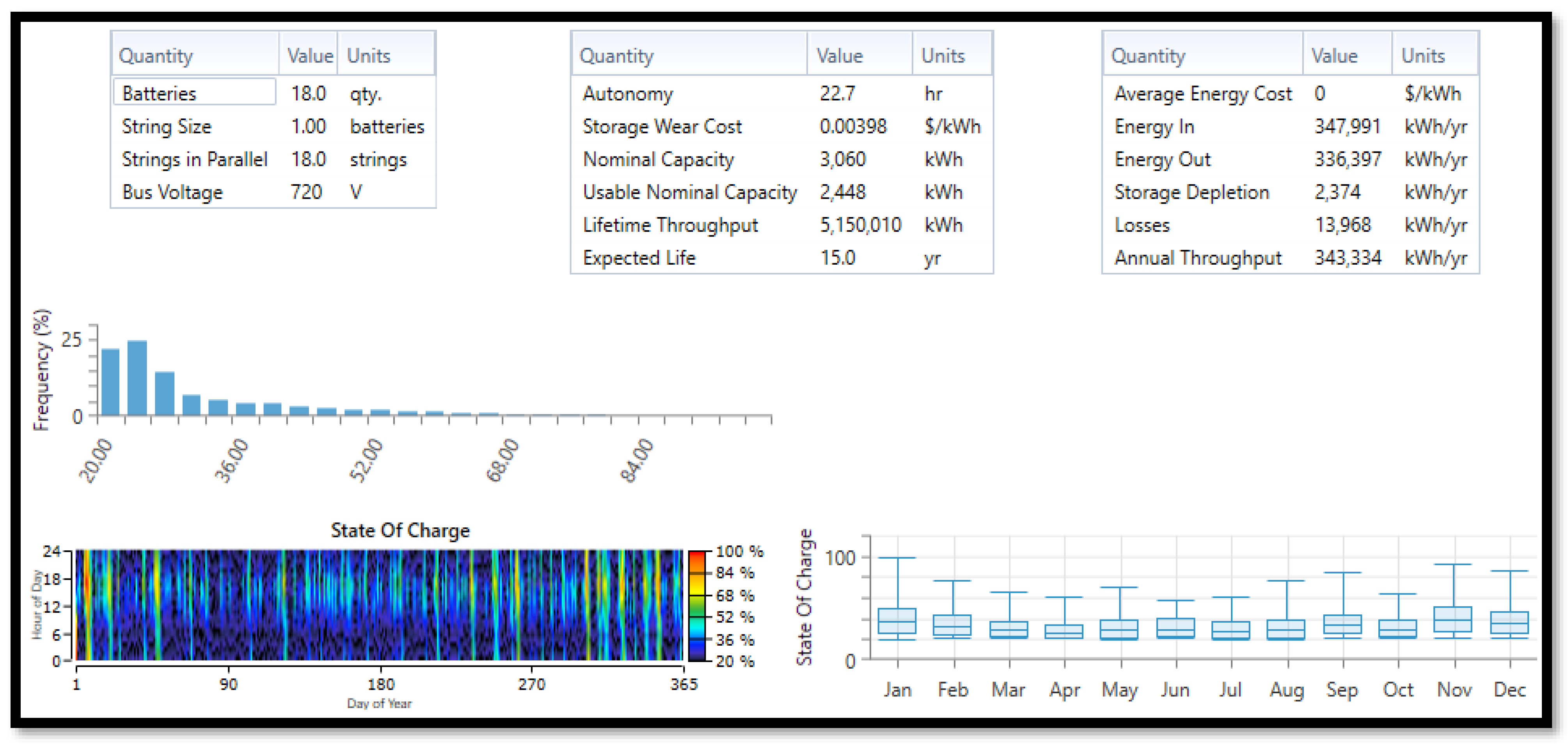
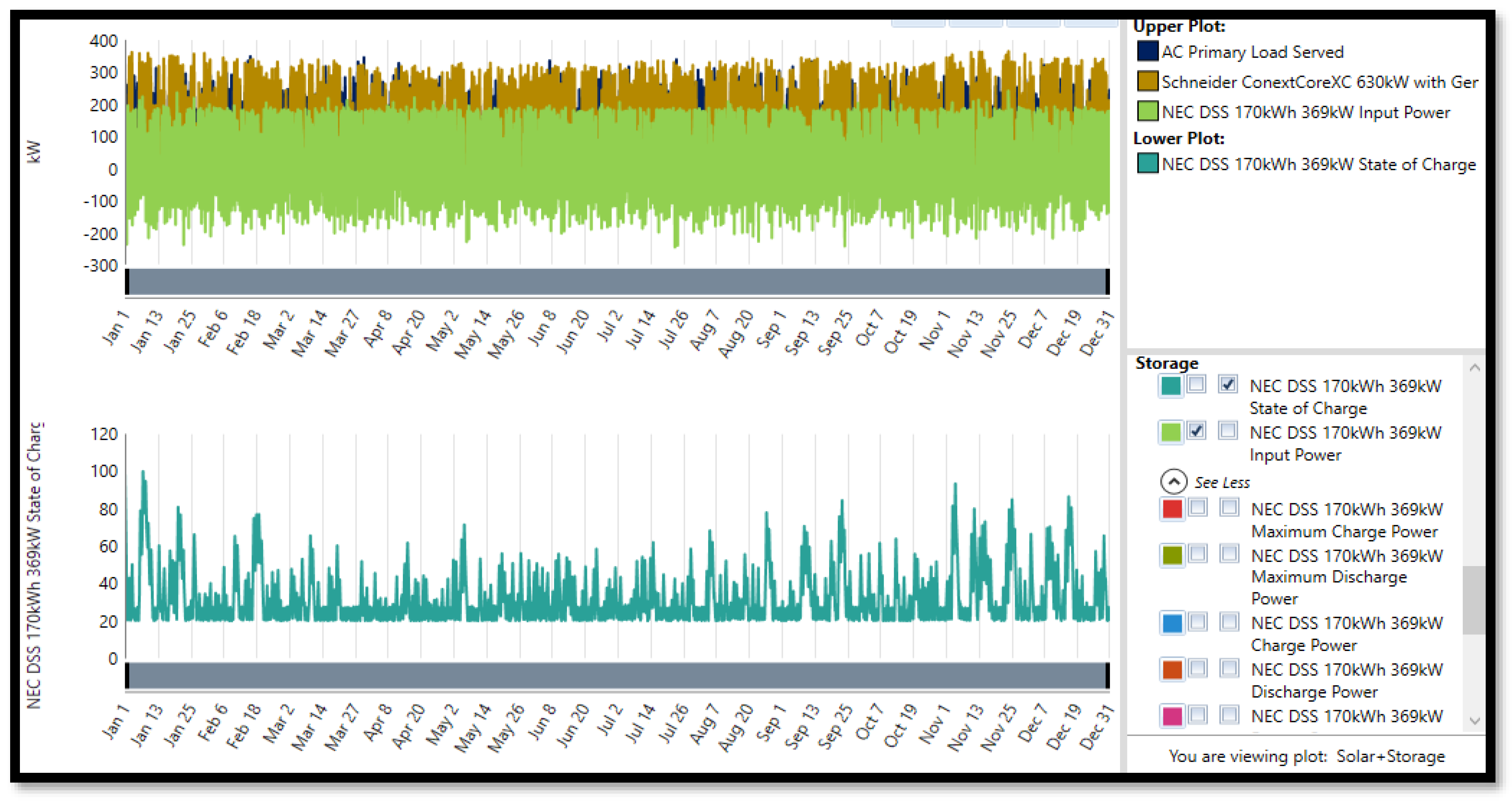

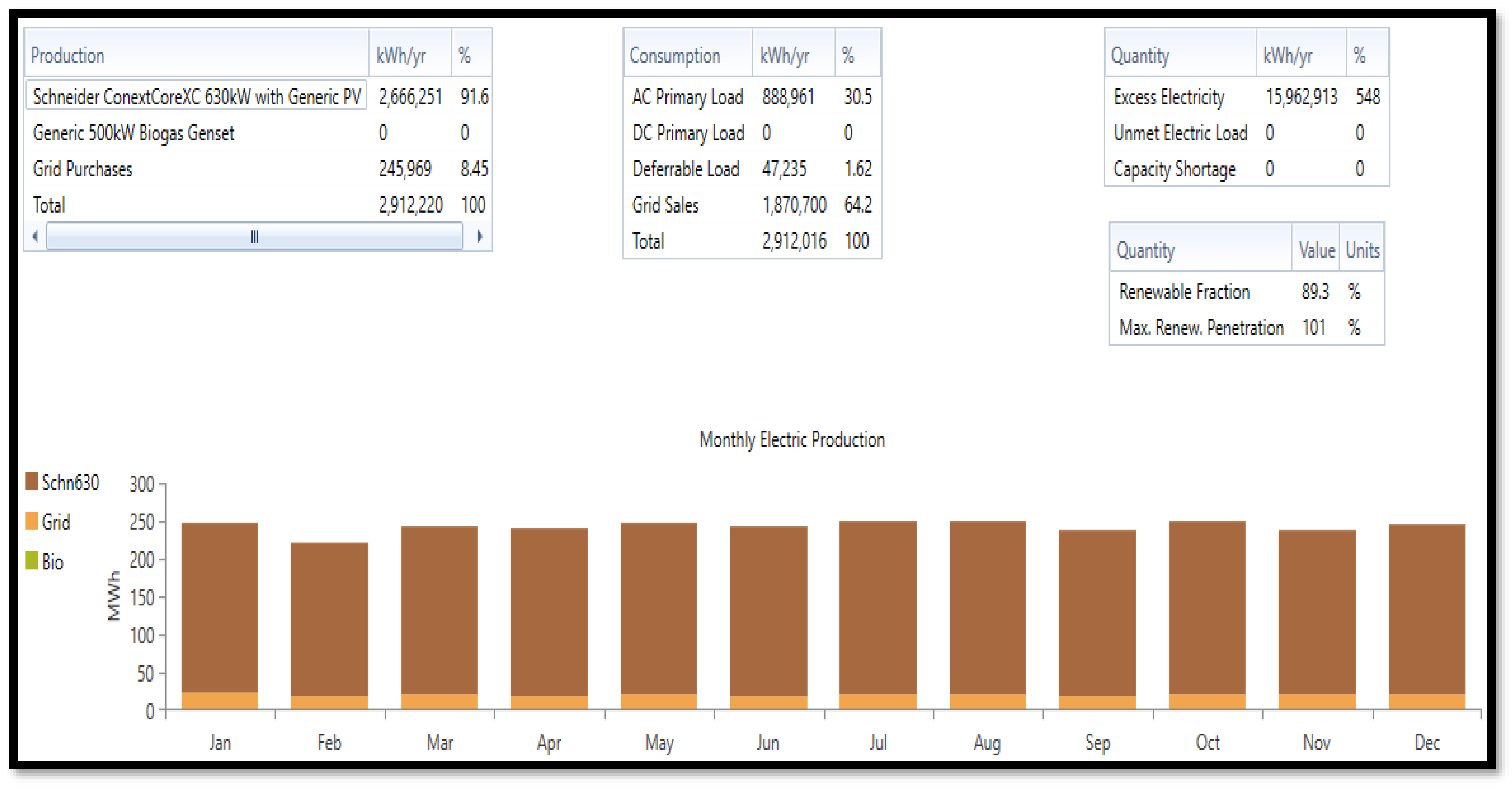

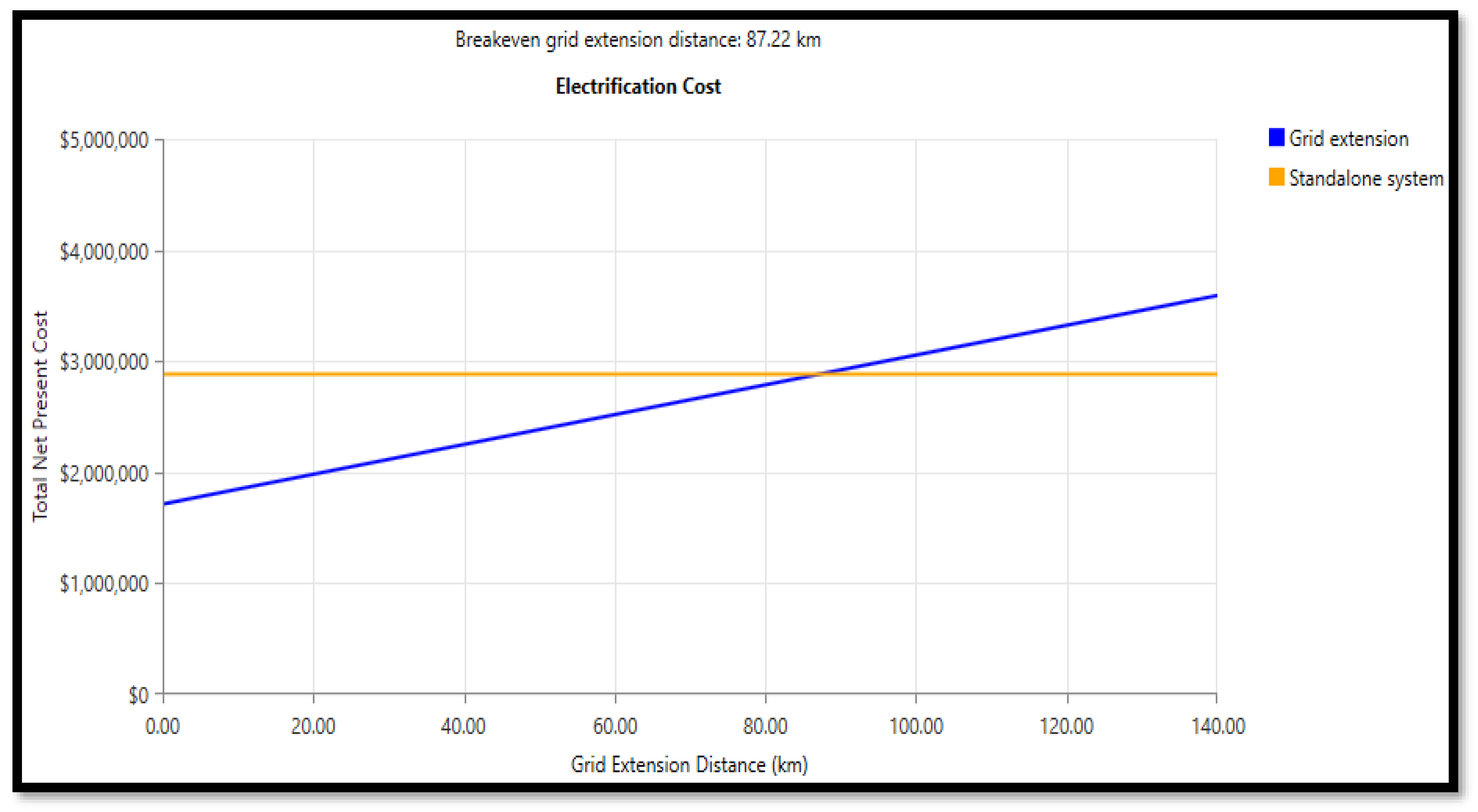
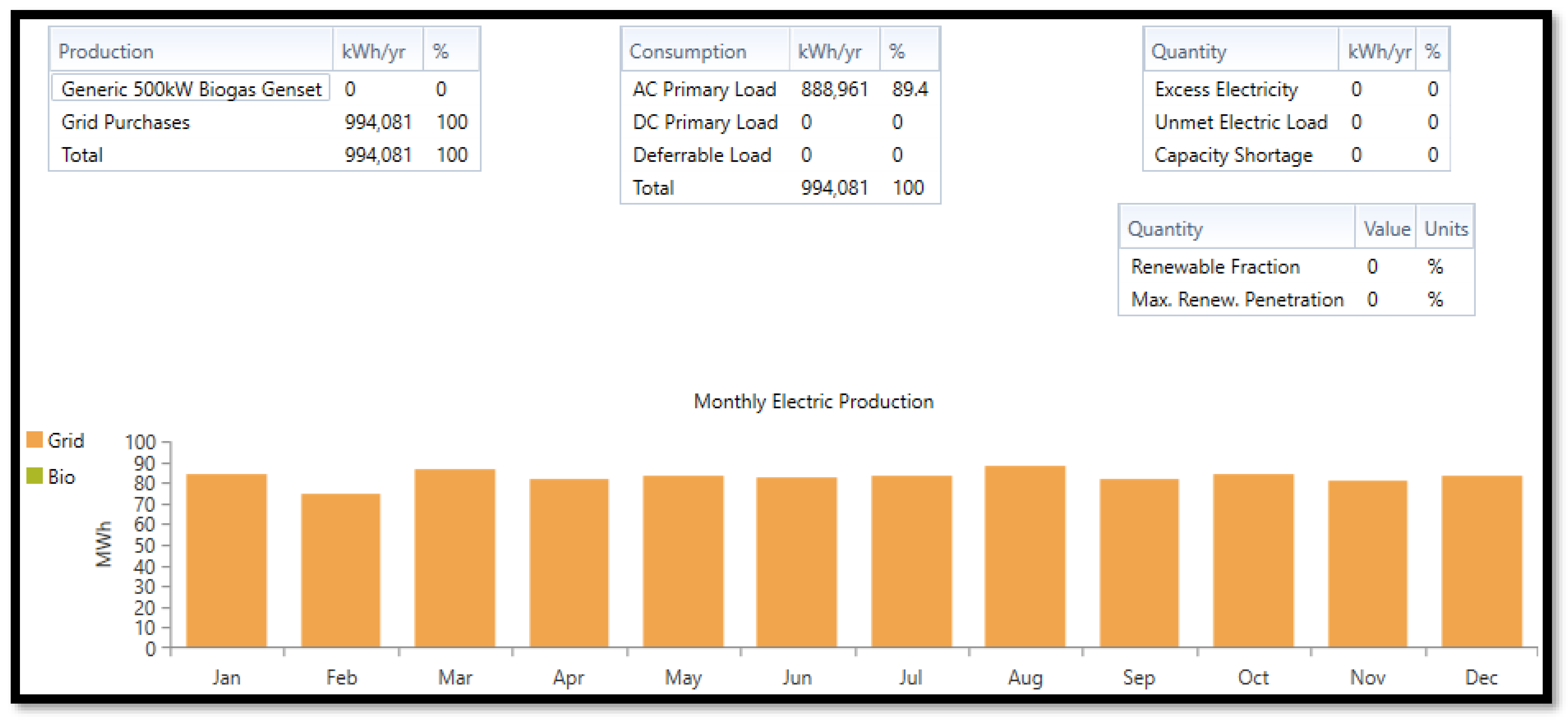
| Batteries | Nominal Voltage Rating (V) | Nominal Capacity Rating (kWh) | Nominal Capacity Rating (Ah) | Round-Trip Efficiency (%) | Maximum Charge Current Rating (A) | Maximum Discharge Current Rating (A) |
|---|---|---|---|---|---|---|
| Sodium Sulfur (NaS) | 192 | 1450 | 7550 | 85.0 | 1200 | 1410 |
| Iron flow (Fe-ESS) | 850 | 400 | 471 | 75.0 | 157 | 118 |
| Lithium-NMC | 720 | 170 | 236 | 96.0 | 628 | 628 |
| Month | Monthly Mean Solar Global Horizontal Irradiance (GHI) Data | Daily Temperature (°C) | |
|---|---|---|---|
| Clearness-Index | Radiation per Day (kWh/m2/dy) | ||
| January | 0.5770 | 5.8100 | 26.640 |
| February | 0.5770 | 5.9900 | 27.200 |
| March | 0.5500 | 5.7800 | 27.580 |
| April | 0.5610 | 5.7200 | 27.570 |
| May | 0.5880 | 5.6800 | 27.020 |
| June | 0.6230 | 5.8000 | 25.160 |
| July | 0.6210 | 5.8600 | 23.940 |
| August | 0.5920 | 5.8700 | 23.840 |
| September | 0.5740 | 5.9300 | 24.520 |
| October | 0.5870 | 6.0800 | 25.430 |
| November | 0.5810 | 5.8600 | 26.140 |
| December | 0.5810 | 5.7600 | 26.310 |
| Yearly Average (kWh/m2/dy): 5.8500 | Yearly Average (°C): 25.950 | ||
| Residential Environment | Metric | Quantity |
| Average Loads (kWh/day) | 11.26 | |
| Average Loads rating (kW) | 0.47 | |
| Peak Loads rating (kW) | 2.09 | |
| Loads (ratio) factor | 0.225 |
| Community Environment | Metric | Quantity |
| Average Load (kWh/day) | 165.44 | |
| Average Load rating (kW) | 6.89 | |
| Peak Loads rating (kW) | 20.46 | |
| Load (ratio) factor | 0.337 |
| Commercial environment | Metric | Quantity |
| Average Loads (kWh/day) | 2424.25 | |
| Average Loads rating (kW) | 101.01 | |
| Peak Loads rating (kW) | 348.08 | |
| Loads (ratio) factor | 0.2902 |
| Power Generation Plants | Rated Capacity | Efficiency (%) | |
|---|---|---|---|
| Power (kW) | Voltage (V) | ||
| Solar Photovoltaic | 630 | 600 DC | 17.3 |
| Biomass Gas Genset | 500 | 480 AC | 35.0 |
| Sodium Sulfur (NaS) Battery | 271 | 634 DC | 85.0 |
| Iron Flow–Energy Storage (Fe-ESS) | 100 | 600 DC | 75.0 |
| Lithium Nickel Manganese Cobalt Oxide (Li-NMC) Battery | 452 | 648 DC | 96.0 |
| Power Store Flywheel | 458 | 600 AC | 95.0 |
| Thermal Load Controller Boiler | 100 | 600 AC | 85.0 |
| Leonics GTP519S (Bidirectional Converter) | 900 | 700 AC↔DC | 96.0 |
| Output Power of Biomass Generator (kW) | Biomass Fuel Consumption Rate (kg/h) |
|---|---|
| 0 | 0.1 |
| 50 | 100.1 |
| 100 | 200.1 |
| 150 | 300.1 |
| 200 | 400.1 |
| 250 | 500.1 |
| 300 | 600.1 |
| 350 | 700.1 |
| 400 | 800.1 |
| 450 | 900.1 |
| 500 | 1000.1 |
| Fuel | Biogas |
|---|---|
| Fuel Curve Intercept (kgh−1) | 0.100 |
| Fuel Curve Slope (kg/hkW−1) | 2.000 |
| Emissions | Carbon Monoxide (CO) (g/kg fuel) | Unburnt Hydrocarbon (CH) (g/kg fuel) | Particulates (g/kg fuel) | Fuel Sulfur to Particulate Matter (%) | Nitrogen Oxide (NOX) (g/kg fuel) |
| 2.00 | 0.00 | 0.00 | 0.00 | 1.25 |
| Lower Heating Value (MJkg−1) | 5.500 |
| Density (kgm−3) | 0.720 |
| Carbon Content (%) | 2.000 |
| Sulfur Content (%) | 0.000 |
| Energy System Architecture | Unmet Electric Load/Capacity Shortage (kWhyr−1) | Excess Electricity (kWhyr−1) | Fraction of Renewable Penetration (%) | Control System |
|---|---|---|---|---|
| Solar-BMGs-TLC-Boiler-Fe-Flywheel | 0 | 93.4 | 93.9 | Load following |
| Solar-BMGs-TLC-Boiler-NaS-Flywheel | 0 | 1088 | 93.9 | Load following |
| Solar-BMG-TLC-Boiler-Li-NMC-Flywheel | 0 | 171 | 93.9 | Load following |
| Energy System Configuration | Carbon Di-Oxide (CO2) (kgyr−1) | Carbon Mono-Oxide (CO) (kgyr−1) | Unburnt Hydrocarbon (CXn Hyn) (kgyr−1) | Particulate Matters (PM) (kgyr−1) | Sulfur Dioxide (SO2) (kgyr−1) | Nitrogen Oxides (NOXn) (kgyr−1) |
|---|---|---|---|---|---|---|
| Solar/BMGs/TLC/Fe-ESS/Flywheel | 19,193 | 1.03 | 0 | 0 | 47.4 | 0.643 |
| Solar/BMGs/TLC/NaS/Flywheel | 19,045 | 0.260 | 0 | 0 | 47.2 | 0.163 |
| Solar/BMGs/TLC/Li-NMC/Flywheel | 19,269 | 1.91 | 0 | 0 | 47.3 | 1.20 |
| Grid/Solar/BMGs/TLC/Fe-ESS/Flywheel | 155,452 | 0 | 0 | 0 | 674 | 330 |
| Grid/Solar/BMGs/TLC/NaS/Flywheel | 153,495 | 0 | 0 | 0 | 665 | 325 |
| Grid/Solar/BMG/TLC/Li-NMC/Flywheel | 154,130 | 0 | 0 | 0 | 668 | 327 |
| Energy System Architecture | Grid Purchase (kWhyr−1) | Grid Sales (kWhyr−1) | Excess Electricity (kWhyr−1) | Fraction of Renewable Penetration (%) |
|---|---|---|---|---|
| Grid/Solar/BMGs/TLC-Boiler/Fe | 191,445 (6.70%) | 1,922,883 (67.3%) | 16,298,342 (570%) | 91.4 |
| Grid/Solar/BMGs/TLC/Boiler/NaS | 189,744 (6.64%) | 1,922,008 (67.2%) | 16,299,299 (570%) | 91.4 |
| Grid/Solar/BMG/TLC/Boiler/Li-NMC | 191,064 (6.68%) | 1,922,751 (67.3%) | 16,298,299 (570%) | 91.4 |
Disclaimer/Publisher’s Note: The statements, opinions and data contained in all publications are solely those of the individual author(s) and contributor(s) and not of MDPI and/or the editor(s). MDPI and/or the editor(s) disclaim responsibility for any injury to people or property resulting from any ideas, methods, instructions or products referred to in the content. |
© 2023 by the authors. Licensee MDPI, Basel, Switzerland. This article is an open access article distributed under the terms and conditions of the Creative Commons Attribution (CC BY) license (https://creativecommons.org/licenses/by/4.0/).
Share and Cite
Akinte, O.O.; Plangklang, B.; Prasartkaew, B.; Aina, T.S. Energy Storage Management of a Solar Photovoltaic–Biomass Hybrid Power System. Energies 2023, 16, 5122. https://doi.org/10.3390/en16135122
Akinte OO, Plangklang B, Prasartkaew B, Aina TS. Energy Storage Management of a Solar Photovoltaic–Biomass Hybrid Power System. Energies. 2023; 16(13):5122. https://doi.org/10.3390/en16135122
Chicago/Turabian StyleAkinte, Oluwaseun Olanrewaju, Boonyang Plangklang, Boonrit Prasartkaew, and Taiwo Samuel Aina. 2023. "Energy Storage Management of a Solar Photovoltaic–Biomass Hybrid Power System" Energies 16, no. 13: 5122. https://doi.org/10.3390/en16135122
APA StyleAkinte, O. O., Plangklang, B., Prasartkaew, B., & Aina, T. S. (2023). Energy Storage Management of a Solar Photovoltaic–Biomass Hybrid Power System. Energies, 16(13), 5122. https://doi.org/10.3390/en16135122







